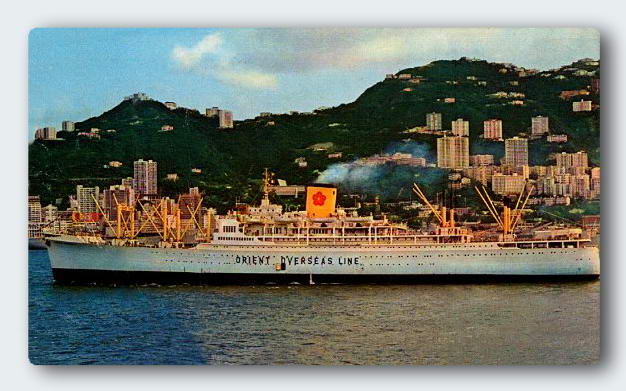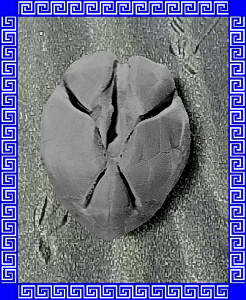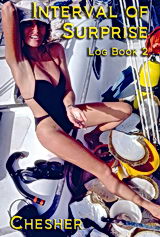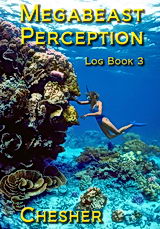LOG OF THE MOIRA
Aboard the Oriental Esmeralda 
Somewhere in the Mid Pacific
The Scientific Voyage of the Research Vessel Moira. Commissioned by the Moirae, in search of a vague theory about how destiny and evolution are intertwined. Bound for the Islands of the South Pacific. First destination, Malaupina Island in the Three Sisters Group in the Solomon Islands.
The voyage properly began a long time ago, in 1958. I first met Moira on a beach near Bear Cut on Virginia Key, just south of Miami and across the Rickenbacker Causeway from the University of Miami's Institute of Marine Sciences. There I was, ambling along the beach, head down, kicking the sand, looking at the tideline, thinking we would never make it from the water to the bushes without being shot. John, our instructor at Carl Gage's Divers Training Academy, wanted us to learn how to infiltrate a beach at night. As a retired U.S. Navy Frogman, John felt it was the sort of training all future professional divers needed. The tide would be low, the moon would be inconveniently full and high in the sky when the boat dropped us off. The beach would be very wide and flooded with light. This, combined with the fact the men in the bushes would already know we would be trying to get ashore, made the exercise a sure fatality.

Bear Cut, Miami 1958I stop and stare at a small spherical object, about an inch in diameter, lying amid the debris of the tideline. I pick it up. It is chalk white, very light, with deep grooves in a star-shaped pattern on one side. I turn it over and over in my hand feeling its dry lightness. As I hold it, I feel a strange sensation....like an aura of static electricity around me....my hair stands up on the nape of my neck....and I am two places, two people at the same time, I am sitting at a desk in a room surrounded with glassware and aquaria and slowly standing up on the beach at Bear's Cut. I am there and here at the same instant. I am student at the marine biological laboratory which borders Bear's Cut and I am a student commercial diver standing on the beach at Bear's Cut. I know one scene is now and the other is somewhen in the future. |
It was over as soon as it began, like seeing a single frame of a movie spliced into the continuing reel of my life. But it was vivid, even shocking. What's more, I knew the scene would take place. Sometime. And I knew the small creature I held in my hand somehow triggered the weird double-vision.
I was the first one killed in the amphibious attack. The flashlight beam caught me squarely in the eyes as I came out of the water on my elbows. I wiggled up onto the beach and dutifully rolled over onto my back and looked up at the stars until the exercise was over. I lay there thinking about the vision of myself somewhere ahead in time. Not lying on some beach at night as some meat-headed professional diver. But seeing myself as a biologist. A scientist. Why not? It would justify my existence as a boat bum and make life much more interesting than being a professional diver. I could be both.
Five years later I sat at a desk in the Agassiz building on the campus of the Institute of Marine Science. Glassware and aquaria surrounded my desk. I was reading a large blue volume of Mortensen's Monograph of the Echinoidea. It was open to the genus Moira. It said there are three species of the genus; M. clotho, M. lachesis, and M. atropos. Moira atropos was the creature I had found on the beach. In the introduction to the genus Dr. Mortensen explained the names come from Greek mythology.
In ancient Greece everyone, even the Gods, were subject to the three sisters of fate, the MOIRAE. Drawings usually show the three sisters at a spinning wheel. Moira clotho sits at the wheel and weaves the thread of life, spinning it from the cosmic wool, Moira lachesis, stands behind her, gathers the thread, and measures how long the thread of life will be. Moira atropos, has a big pair of scissors. She cuts off the thread of life.
Like Agassiz and Mortensen, I was a student of evolution. Echinoids (sea urchins) have left excellent fossils as they evolved and are, in many ways, perfect animals to study the details of evolution. Mortensen's comments about Moira made me think of evolution as a kind of fate. Creatures, like the burrowing heart urchin Moira, were subjected to various ecological forces. These, combined with genetic variations within the species, caused them to change their behavior and later their form. The process extended over thousands, perhaps millions of years.
As far as the individual animals are concerned, evolutionary forces are invisible threads of fate. Thought of that way, I was a student of the process of Fate. A student of Moirae. I smiled to myself and looked up, out the window.
|
I stop and stare at a small sphere shaped creature lying in the debris of the tide line. I feel the warm sand on my feet and the salt air on my face as I bend down and gingerly pick it up, feeling its dry lightness. A feeling of static electricity engulfs me and I am standing up/I am sitting in the Agassiz Building surrounded with glassware and aquaria, feeling, being... |
At that moment the single frame I had seen five years before merged perfectly with the reality of my life. It was a precise fit, complete with cluttered desk, glass aquaria, even the wet cement laboratory smell. The name of the creature on the beach, that cued the prophetic scene, turned out to be Moira. Fate.
I was stunned. The vision played and replayed in my mind. How could this be? Naturally, I, myself made the decisions to become a marine biologist. I decided to get interested in evolution. It could just be a coincidence, being assigned a particular desk in the Agassiz Building that happens to look exactly like the scene in my vision. No doubt my sub-conscious mind helped the illusion by arranging the books and things to match the vision. But I did not know, until that moment, the name of the little creature on the beach, much less the strange link between its name - fate - and the vision and the decision to become what I was and where I was at that moment. How on Earth does something like that work?
There was not the slightest doubt in my mind. It was a prophetic vision and the vision came true. Was it a glimpse of some strange aspect of evolution? A very personal, not at all abstract, aspect of how creatures are directed along certain paths of behavior? At the time, I felt as if some being - or force - was actually guiding me, controlling events around me. God? Moirae? Fate?
The vital question of how evolution works - how the fantastic adaptations we see everywhere in nature came about - has always circled around the idea of some controlling force. Today, budding evolutionary scientists learn a modernized version of Darwin's ideas and sit through elaborate courses in genetics, biochemistry, population dynamics, logic and even philosophy of science. None of the ideas, none of the courses, nothing I could think of in my formal education came close to explaining the little sea urchin in the tide line named after the Greek myth about three sisters who weave the thread of life from the universe, measure how long an individual's life will be and lop it off at the appropriate time.



